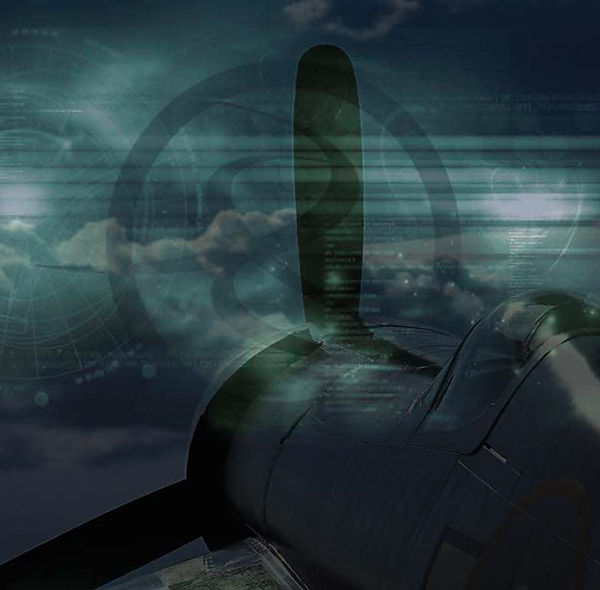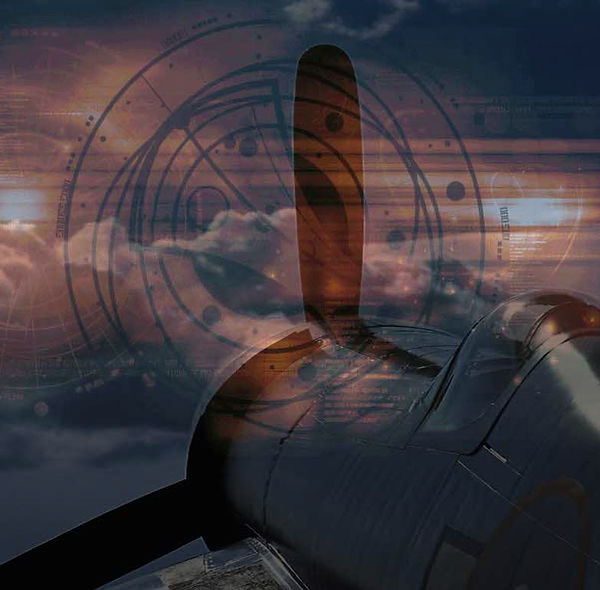
Hold your pointer on a tab in the menu on top of the page to view and handle the sub menus.


Technical issues with the F4U Corsair
In part because of its advances in technology and a top speed greater than existing Navy aircraft, numerous technical problems had to be solved before the Corsair would enter service.
Carrier suitability was a major development issue, prompting changes to the main landing gear, tail wheel and tailhook. Early F4U-1s had difficulty recovering from developed spins, since the inverted gull wing's shape interfered with elevator authority.
It was also found that the Corsair's starboard wing could stall and drop rapidly and without warning during slow carrier landings. In addition, if the throttle were suddenly advanced (for example, during an aborted landing) the port wing could stall and drop so quickly that the fighter could flip over with the rapid increase in power.
These potentially lethal characteristics were later solved through the addition of a small, 6 in (150 mm)-long stall strip to the leading edge of the outer starboard wing, just inboard of the gun ports. This allowed the starboard wing to stall at the same time as the port.
Other problems were encountered during early carrier trials. The combination of an aft cockpit and the Corsair's long nose made landings hazardous for newly trained pilots.
During landing approaches it was found that oil from the hydraulic cowl flaps could spatter onto the windscreen, badly reducing visibility, and the undercarriage oleo struts had bad rebound characteristics on landing, allowing the aircraft to bounce out of control down the carrier deck.
The first problem was solved by locking the top cowl flap down permanently, then replacing it with a fixed panel. The undercarriage bounce took more time to solve but eventually a "bleed valve" incorporated in the legs allowed the hydraulic pressure to be released gradually as the aircraft landed.
The Corsair was not considered fit for carrier use until the wing stall problems and the deck bounce could be solved.
Meanwhile, the more docile and simpler-to-build F6F Hellcat had begun entering service in its intended carrier-based use. Compared to the Hellcat, the Navy regarded the Corsair as fundamentally flawed for their requirements.
While slower than the Corsair, the Hellcat was much preferred by the Navy since the Hellcat was much simpler to land on a carrier. The Hellcat's great success combined with the Corsair's carrier landing issues meant the Navy released the Corsair to the U.S. Marine Corps.
With no requirement for carrier landings, the Marine Corps deployed the Corsair to widespread and devastating effect from land bases.
Corsair deployment aboard U.S. carriers was delayed until late 1944 by which time the carrier landing problems had been tackled by the British.
LANDING ISSUES and CARRIER QUALIFICATIONS (* Roy Lindberg).
There has been discussion about the inexperienced Navy pilots inability to land safely aboard an aircraft carrier and become "deck qualified."
The early trials indicated deficiencies that could be overcome by an experienced pilot but were problematic for training Navy pilots. As a result, the Corsair gained the early reputation as an "ensign eliminator."
Now the argument or misunderstandings arise. When was the Corsair officially approved for carrier combat operations?
Secondly there are questions as to why the Corsair approval was withheld? Was it because of the design deficiencies which made the Corsair difficult to make safe carrier landings or was it because there were "logistics" issues?
In March 1944, the Chief of Naval Air Operational Training, Jacksonville, Florida, drafted a letter condemning the Corsairs from carrier operations. The prime reason for this, the F4Us, especially when in the hands of inexperienced pilots, tended to bounce on deck landings.
Student pilot attrition rate was high.
Had the letter been released, the Corsair probably would have been deleted for all time as a carrier-based fighter.
But because of the efforts of Chance Vought's Jack Hospers, Captain John Pearson (USN Fighter Design Officer in the Bureau of Aeronautics), and Captain H. S. Duckworth (USN Chief of Staff, Fleet Air Jacksonville), the letter was held up. "Program Dog" was instituted immediately.
The program, one of four that Vought engineers presented, took just 10 days to complete. It went right to the heart of the program improving the oleo characteristics of the landing gear. By doing so, the "built-in bounce" of the Corsair was eliminated. Test flight results with the improved gear.
Commander T. K. (Kip) Wright, USN and Lieutenant Colonel John Dobbins, USMC) were so successful that the aircraft was immediately endorsed by Commander, Fleet Air Jacksonville. All doubt concerning the Corsair's carrier landing characteristics was resolved aboard the carrier USS Gambier Bay in April 1944. Navy Squadron VF-301, equipped with F4U-ls which had the improved oleo struts, completed 113 landings with excellent results.
As a result of the USS Gambier Bay trials, an order was issued to modify the oleo struts on all West Coast Corsairs. The Corsair was now completely acceptable for carrier duty.
WWII STANDARD NAVY CARRIER APPROACH TRAINING
See www.warhistoryonline.com/world-war-ii.
Diagram showing the landing pattern of U.S. Navy aircraft carriers during the Second World War. The aircraft carrier depicted is the Independence-class light carrier USS Belleau Wood (CVL-24).
Design modifications
Production F4U-1s featured several major modifications compared with the XF4U-1. A change of armament to six wing-mounted .50 in (12.7 mm) M2 Browning machine guns (three in each outer wing panel) and their ammunition (400 rounds for the inner pair, 375 rounds for the outer) meant that the location of the wing fuel tanks had to be changed.
In order to keep the fuel tank close to the center of gravity, the only available position was in the forward fuselage, ahead of the cockpit. Accordingly, as a 237 gal (897 l) self-sealing fuel tank replaced the fuselage mounted armament, the cockpit had to be moved back by 32 in (810 mm) and the fuselage lengthened.
In addition, 150 lb of armor plate was installed, along with a 1.5 in (38 mm) bullet-proof windscreen which was set internally behind the curved Plexiglas windscreen.
The canopy could be jettisoned in an emergency, and half-elliptical planform transparent panels, much like those of certain models of the Curtiss P-40, were inset into the sides of the fuselage's turtledeck structure behind the pilot's headrest, providing the pilot with a limited rear view over his shoulders.
A rectangular Plexiglas panel was inset into the lower center section to allow the pilot to see directly beneath the aircraft and assist with deck landings.The engine used was the more powerful R-2800-8 (B series) Double Wasp which produced 2,000 hp (1,491 kW).
On the wings the flaps were changed to a NACA slotted type and the ailerons were increased in span to increase the roll rate, with a consequent reduction in flap span. IFF transponder equipment was fitted in the rear fuselage. These changes increased the Corsair's weight by several hundred pounds.
Engine considerations
The F4U incorporated the largest engine available at the time: the 2,000 hp (1,500 kW) 18-cylinder Pratt & Whitney R-2800 Double Wasp radial.
To extract as much power as possible, a relatively large Hamilton Standard Hydromatic three-blade propeller of 13 feet 4 inches (4.06 m) was used.
Landing gear and wings
To accommodate a folding wing the designers considered retracting the main landing gear rearward but for the chord of wing that was chosen, it was difficult to make the landing gear struts long enough to provide ground clearance for the large propeller.
Their solution was an inverted gull wing, which considerably shortened the required length of the main gear legs.
The anhedral of the wing's center-section also permitted the wing and fuselage to meet at the optimum angle for minimizing drag, without using wing root fairings.
The bent wing was heavier and more difficult to construct, offsetting these benefits. The Corsair's aerodynamics were an advance over those of contemporary naval fighters. The F4U was the first U.S. Navy aircraft to feature landing gear that retracted into a fully enclosed wheel well.
The landing gear oleo struts each with their own strut door enclosing them when retracted rotated through 90° during retraction, with the wheel atop the lower end of the strut when retracted; a pair of rectangular doors enclosed each wheel well, leaving a streamlined wing.
This swiveling, aft-retracting landing gear design was common to the Curtiss P-40 (and its predecessor, the Curtiss P-36), as adopted for the F4U Corsair's main gear and its erstwhile Pacific War counterpart, the Grumman F6F Hellcat.
The oil coolers were mounted in the heavily anhedraled center-section of the wings, alongside the supercharger air intakes, and used openings in the leading edges of the wings, rather than protruding scoops. The large fuselage panels were made of aluminum and were attached to the frames with the newly developed technique of spot welding thus mostly eliminating the use of rivets.
While employing this new technology, the Corsair was also the last American-produced fighter aircraft to feature fabric as the skinning for the top and bottom of each outer wing, aft of the main spar and armament bays, and for the ailerons, elevators and rudder.
The elevators were also constructed from plywood.
The Corsair even with its streamlining and high speed abilities, could fly slowly enough for carrier landings with full flap deployment of 60°.
Performance
The performance of the Corsair was impressive.
The F4U-1 was considerably faster than the Grumman F6F Hellcat and only 13 mph (21 km/h) slower than the Republic P-47 Thunderbolt.
All three were powered by the R-2800. But while the P-47 achieved its highest speed at 30,020 feet (9,150 m) with the help of an intercooled turbocharger,
The F4U-1 reached its maximum speed at 19,900 ft (6,100 ) and used a mechanically supercharged engine

